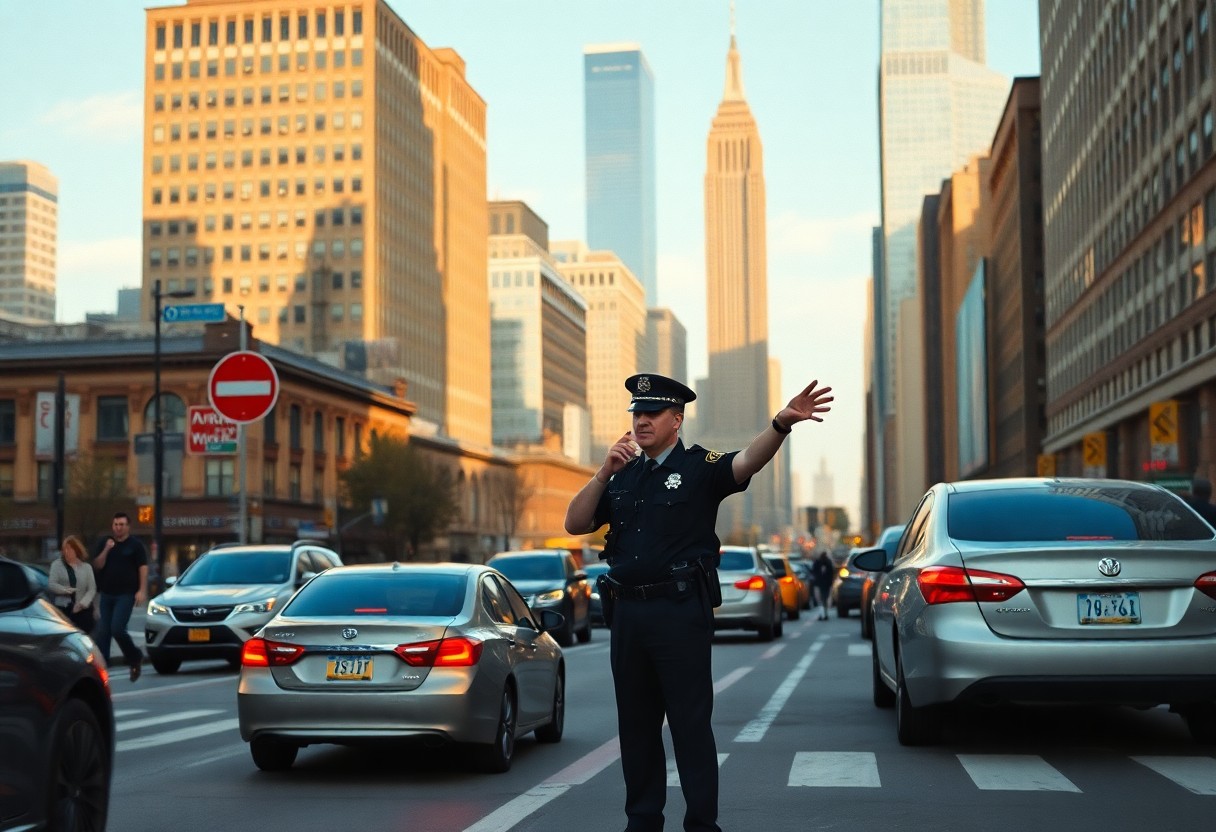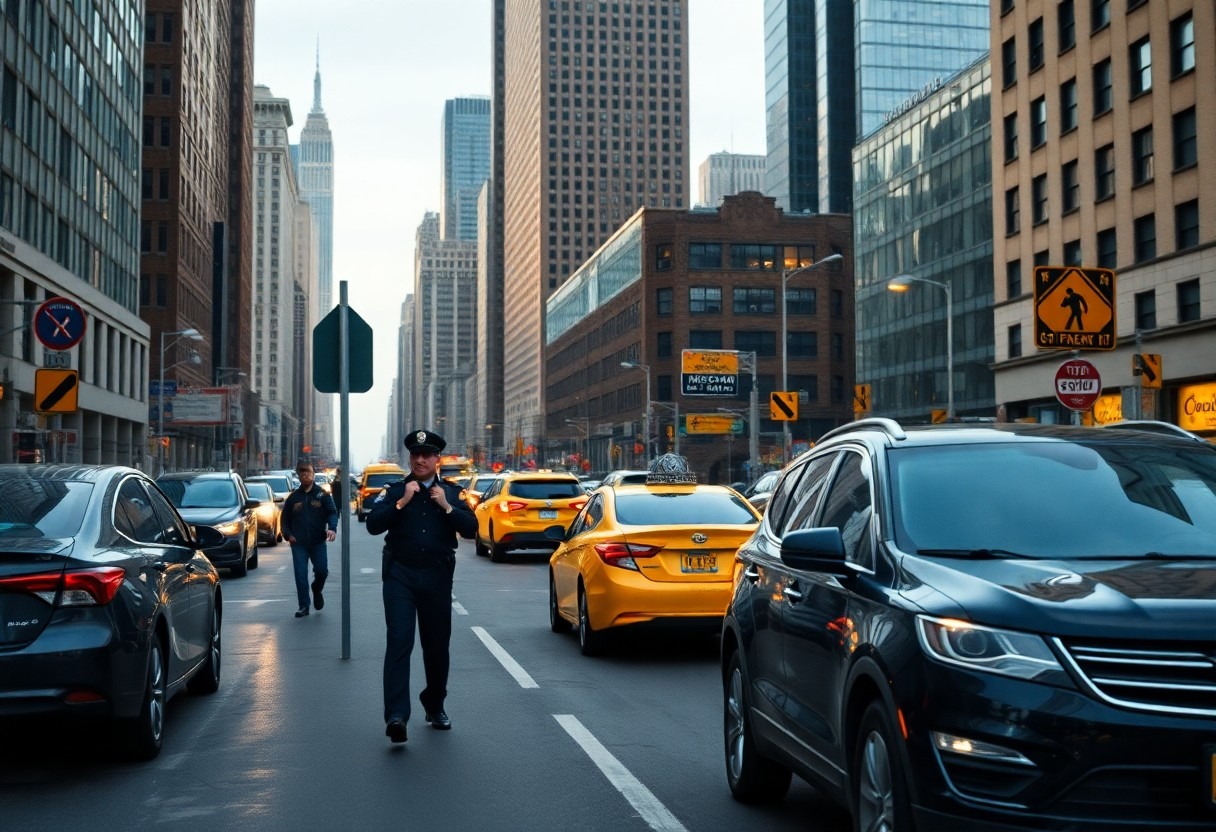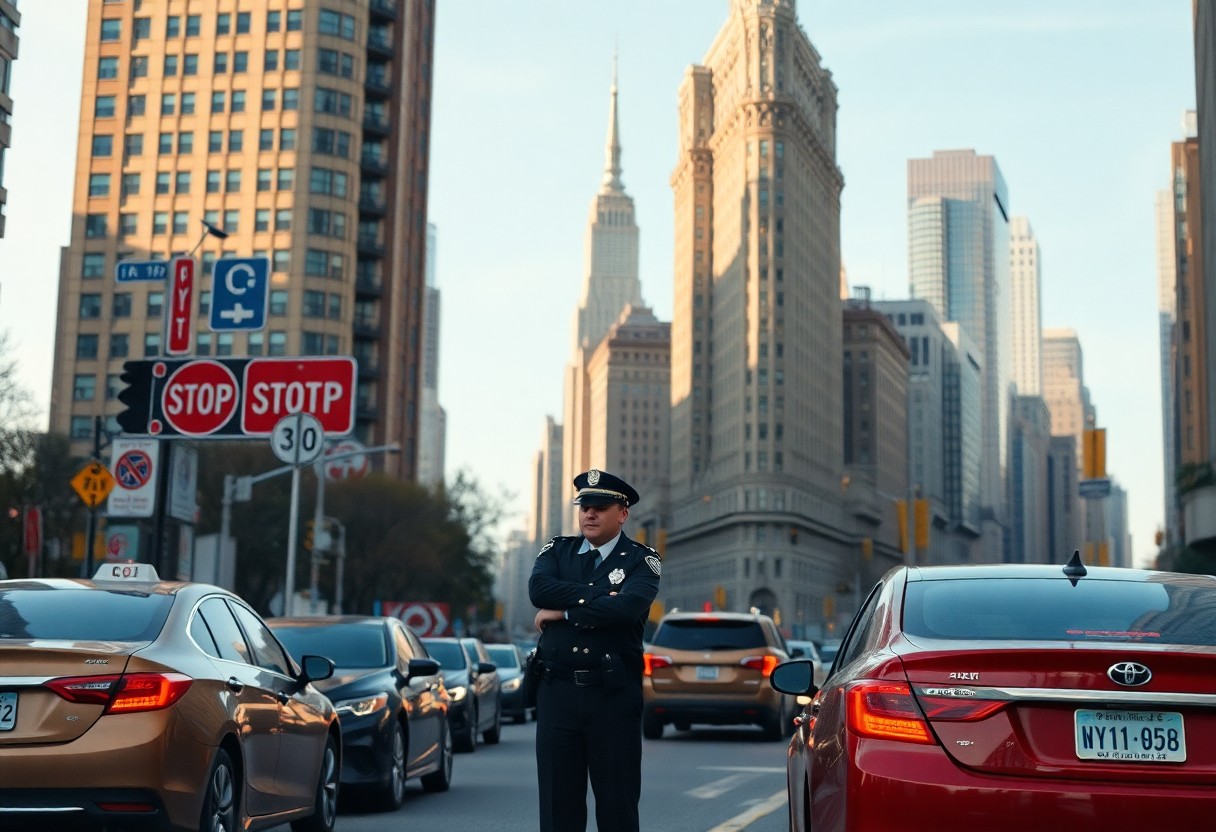To successfully navigate the bustling streets of New York City, it’s essential to understand the unique challenges associated with driving in such a vibrant metropolis. Being behind the wheel in the Empire State requires adapting to heavy traffic conditions while strictly adhering to traffic laws designed to ensure the safety of all road users. Familiarizing yourself with specific local driving laws—such as the 25 mph speed limit in urban areas and the complete ban on using handheld devices while driving—is crucial. Whether you are exploring Manhattan's intricate grid layout or journeying through the scenic upstate regions, a comprehensive understanding of New York’s driving regulations will empower you to confidently navigate its diverse roadways while ensuring you stay safe on New York’s dynamic streets.
Essential Driving Laws to Observe While in New York
In New York, compliance with fundamental driving regulations is vital for ensuring safety on the road. You must always drive on the right side of the road, maintaining a safe distance from the vehicle ahead and using turn signals whenever changing lanes. Your vehicle should be equipped with operational headlights, taillights, and brake lights to guarantee visibility and communicate your intentions to other drivers. Remember, seat belt use is mandatory for all passengers, and children under eight years old must be secured in appropriate restraint systems. These regulations not only promote your safety but also foster a culture of responsibility and awareness on the road, enhancing the overall driving experience for everyone involved.
Comprehending Speed Limits and Traffic Signal Regulations
Speed limits in New York are not uniform; they differ significantly depending on the location and type of roadway. The 25 mph speed limit is the standard in New York City unless otherwise indicated by posted signs, while highways typically allow speeds ranging from 55 to 65 mph. It is imperative to come to a complete stop at red lights and stop signs, as this is a fundamental aspect of safe driving. In NYC, right turns on red lights are prohibited unless there is a specific sign allowing it. Additionally, intersections and school zones are closely monitored by traffic cameras to ensure compliance, which highlights the necessity of remaining vigilant and following all traffic signals diligently.
Yielding to Pedestrians and Mastering Right-of-Way Rules
In addition to standard traffic laws, it is essential to always yield to pedestrians in crosswalks, whether they are clearly marked or not. This responsibility includes stopping for school buses that display flashing red lights and yielding to emergency vehicles. Failure to yield to pedestrians can lead to substantial fines and points on your license, adversely affecting your driving record. Exercising extra caution in school zones and residential areas is crucial due to the increased volume of pedestrian traffic. Remember, pedestrians have the right-of-way when crossing with the signal, and you must remain stopped until they have completely cleared the crosswalk. Blocking crosswalks or intersections, even momentarily, should be avoided to safeguard all road users.
Moreover, it’s vital to acknowledge that the responsibility for pedestrian safety lies heavily on drivers, particularly in areas with high foot traffic. This means being especially attentive during peak hours when children are arriving or departing from school. Always be on the lookout for pedestrians who may unexpectedly enter the roadway and be ready to stop. By prioritizing pedestrian safety, you contribute to creating a more secure driving environment for everyone.
Ensuring Your Vehicle Meets Safety and Compliance Standards
Before venturing onto the busy streets of New York, it’s imperative that your vehicle meets specific state requirements to guarantee safety and compliance. Regular maintenance is crucial, which includes ensuring that your car has functional headlights, properly inflated tires, and well-maintained brakes. The New York Department of Motor Vehicles (DMV) mandates annual safety inspections for all registered vehicles to confirm they meet safety standards. This is vital for the well-being of all drivers and passengers on the road. Staying on top of these requirements not only helps you avoid penalties but also enhances your vehicle's performance and reliability, ensuring that you are prepared for any driving situation.

Understanding the Importance of Vehicle Registration and Insurance
Every vehicle legally operating in New York must possess the proper documentation, including maintaining minimum liability insurance coverage of $25,000/$50,000 for bodily injury and $10,000 for property damage. Keeping your vehicle registration current is also critical, and you must display valid inspection stickers on your windshield as proof of compliance. Failure to meet these requirements can lead to significant fines and even license suspension, complicating your ability to drive legally. By ensuring that all necessary documentation is in order, you protect yourself against potential legal issues and ensure a smoother driving experience in New York.
Meeting New York's Comprehensive Safety Equipment Standards
In addition to registration, ensuring your vehicle complies with New York’s safety equipment standards is crucial for legal operation. Your vehicle must be equipped with functioning headlights, brake lights, turn signals, and windshield wipers to enhance visibility and ensure effective communication with other drivers. The state also mandates that vehicles are equipped with functional seat belts, mirrors, and a horn, all of which are essential for your safety and the safety of others on the road. Furthermore, New York’s equipment regulations extend beyond basic requirements, including maintaining proper emission standards and undergoing regular smog checks to minimize environmental impact. Regularly inspecting these components will help ensure that your vehicle is safe and compliant with state laws.
Moreover, it is critical to frequently check your vehicle for adequate tire tread depth, properly functioning brakes, and operational defrosters to prepare for various weather conditions. Additionally, having emergency equipment such as hazard lights and reflectors readily available is essential for unexpected situations. By adhering to these safety equipment standards, you not only comply with the law but also contribute to a safer driving environment for all road users.

Complying with Local Regulations in Special Zones
When driving in New York, it is essential to exercise extra caution and adhere to specific local regulations in designated zones. Certain areas, such as school zones, construction sites, and residential neighborhoods, have their own set of rules that must be strictly followed to ensure safety. Violating regulations in these areas can lead to significant fines, which can range from $90 to $600 depending on the severity of the infraction. Understanding and respecting these local laws is vital for ensuring the safety of all road users and maintaining a harmonious driving environment throughout the city.
Staying Alert in School and Work Zones
School and work zones are among the most critical areas that require your utmost attention while driving. In these zones, you are required to reduce your speed to 15-20 mph during school hours, ensuring the safety of vulnerable pedestrians, especially children. When navigating through work zones, adhering to posted speed limits and maintaining a safe distance from construction workers is not just courteous but essential. Fines for speeding in these areas are often doubled, which underscores the importance of heightened safety awareness. By remaining vigilant and following the rules in these zones, you play an integral role in protecting those who are most at risk.
Mastering Parking Regulations to Prevent Unnecessary Fines
Understanding the critical parking rules in New York is essential to avoid unnecessary fines and inconveniences that can arise from violations. Alternate-side parking regulations are enforced in most areas, so it is important to pay close attention to posted signs that indicate specific days and times for parking restrictions. Metered parking zones are widespread throughout the city, with rates differing by location and time of day, so always check the meter before leaving your vehicle. Additionally, you must adhere to strict fire hydrant clearance regulations (a minimum of 15 feet) and avoid no-standing zones near intersections to ensure compliance and safety.
Moreover, being aware of residential permit requirements in certain neighborhoods is crucial to preventing parking violations. Failure to comply with these regulations can result in fines ranging from $65 to $115, and your vehicle may be towed if you obstruct essential services or create safety hazards. Staying informed and compliant with parking regulations will save you from costly penalties and enhance your overall experience while driving in New York.
Essential Driver’s License Requirements for New York Residents
Possessing a valid driver’s license is crucial for legal driving in New York. To operate a vehicle, you must be at least 16 years old and hold either a New York State driver’s license or a valid out-of-state license. If you are a first-time driver, completing a state-approved driver education course and passing both written and road tests is mandatory. These requirements are strategically designed to ensure that all drivers are sufficiently prepared to navigate New York’s complex and often challenging roadways.
Understanding New York Driver’s License Classifications
One of the most important aspects of driving in New York is understanding the various classifications of licenses. Class D is the standard license for passenger vehicles, while commercial driver’s licenses (CDL) range from Class A to C, each with specific privileges and restrictions regarding the types of vehicles you can legally operate. Knowing the distinctions among license classes is vital to ensuring you have the correct credentials for the vehicle you plan to drive, thus avoiding legal issues and contributing to overall road safety.
Guidelines for Out-of-State License Holders Moving to New York
If you hold an out-of-state license, it remains valid for up to 30 days after establishing residency in New York. As a tourist or temporary resident, you can legally drive with your home state’s license. International visitors must possess a valid foreign license along with an International Driving Permit to drive legally in New York. Additionally, specific protocols apply to military personnel and their families, allowing them to maintain their home-state licenses while stationed in New York. If you become a permanent resident, you must exchange your out-of-state license within 30 days by visiting a DMV office and passing a written test to ensure compliance with state regulations.
Implementing Safety Measures for a Secure Driving Experience
For your safety on New York roads, adhering to strict traffic regulations and maintaining constant awareness of your surroundings is paramount. Your vehicle should be equipped with essential safety features, including functional headlights, taillights, turn signals, and properly inflated tires. Regular vehicle maintenance is not just encouraged but crucial for safe driving, particularly in New York’s demanding traffic conditions. By prioritizing these safety measures, you can substantially reduce the risk of accidents and ensure a safer driving experience overall.
Child Safety Requirements to Ensure Young Passenger Protection
To protect young passengers, any child under eight years old must be secured in an appropriate child restraint system. Children under two years of age are mandated to ride in a rear-facing car seat, while those between the ages of two and four must utilize a forward-facing car seat. For children aged four to eight, booster seats are necessary to ensure their safety. Violations of these requirements can incur fines of up to $100 and three penalty points on your license. By enforcing these child safety measures, you contribute to the protection of our youngest and most vulnerable passengers on the road, ensuring their safety in every journey.
Seatbelt Compliance and Regulations on Mobile Device Usage
To enhance safety for you and your passengers, mandatory seatbelt use for all vehicle occupants is enforced in New York. It is essential to ensure that everyone in the vehicle is buckled up, regardless of where they are seated. The use of handheld devices while driving is strictly prohibited, with fines ranging from $50 to $450 for violations, which vary depending on whether it is a repeat offense. Remember, even a momentary distraction can lead to severe consequences on New York roads.
Your first violation of mobile device laws results in five driver violation points, and subsequent offenses may lead to license suspension. While hands-free devices are permitted, it’s advisable to minimize their use to maintain focused attention on the road at all times. By adhering to these regulations, you not only protect yourself but also contribute to the overall safety of the driving environment in New York.

Awareness of Traffic Violations and Their Consequences
Navigating New York’s traffic laws requires your constant vigilance and attention to detail. The city enforces strict compliance with traffic regulations, and violations can lead to severe consequences. Understanding these rules is not merely about avoiding fines; it’s also critical for maintaining road safety for everyone involved. Being aware of potential infractions can significantly reduce your risk of accidents and legal issues, ultimately contributing to a safer driving environment.
Recognizing Common Traffic Violations in New York
On the bustling streets of New York, some of the most common traffic violations include speeding (particularly in school zones), running red lights, illegally using mobile phones, and making improper turns. The likelihood of enforcement is high, as the city employs both traditional police patrols and automated enforcement systems to monitor compliance. Recent statistics indicate that speed cameras alone issued over 4 million violations in 2022, highlighting the critical importance of adhering to speed limits and traffic signals to avoid severe penalties.
Understanding the Penalties, Fines, and Their Implications
When it comes to penalties for traffic violations, first-time offenders may face fines ranging from $50 to b,000, depending on the nature of the offense. The New York DMV utilizes a point system, where accumulating 11 points within 18 months can lead to license suspension. Furthermore, your insurance rates may see a significant increase following any violations, which can impact your financial standing. It’s important to recognize that New York employs a graduated penalty system; thus, repeat offenses result in progressively severe consequences. Violations can remain on your driving record for up to four years, potentially affecting your insurance rates and driving privileges. The state’s zero-tolerance policy for DUI offenses can lead to immediate license suspension and mandatory court appearances, underscoring the urgent need for responsible driving.
Key Takeaways for Safe Driving in New York
Driving in New York demands your complete attention and adherence to a variety of specific regulations. Your safety, as well as that of others, depends on following speed limits, yielding to pedestrians, and ensuring proper child restraints are in place. You can find well-maintained vehicles that meet all safety requirements through RentaCar24.org, allowing you to navigate the city with confidence. By staying informed about local traffic laws and keeping these essential guidelines in mind, you’ll be well-prepared to handle the challenges of New York’s busy streets. Understanding and respecting these driving regulations will contribute significantly to a smoother and safer driving experience throughout the Empire State.
The Article: Driving in New York: Essential Rules and Regulations for Safe Travel appeared first on https://rentacar24.org/
The Article Essential Rules and Regulations for Safe Driving in New York Was Found On https://limitsofstrategy.com



Navigating the streets of New York City can indeed be an overwhelming experience, especially for those who may be unfamiliar with the rhythm and nuances of urban driving. I can certainly relate to the challenges you mentioned. When I first drove there, I was struck by how quickly things can change from a wide-open street to bumper-to-bumper traffic in a matter of moments. The need to stay alert and adapt rapidly is vital, and it’s refreshing to see this aspect emphasized in your post.
I completely understand where you’re coming from. The contrast between the open stretches of road and suddenly having to navigate around a sea of cars is striking, and it can be so disorienting at first. For me, the experience was almost like learning a new rhythm—finding your place in a chaotic dance.
It’s interesting how driving in NYC can really make you feel the pulse of the city. That sudden shift from open roads to gridlock really depicts the unpredictability of urban life. I remember when I first drove there as well; I was caught off guard by how quickly you have to switch your mindset.
Navigating New York City’s streets can indeed feel like a high-stakes adventure, whether you’re a seasoned driver or a visitor trying to get a feel for the city. I remember my first time driving in Manhattan—I was practically glued to my GPS while trying to keep an eye out for cyclists and pedestrians darting everywhere! It’s amazing how the city’s culture influences driving habits; the honking is practically a language of its own.
It’s interesting to consider how New York City’s driving experience serves as a microcosm for broader urban living challenges. The dense traffic, strict regulations, and necessity for vigilance not only highlight the specific nuances of driving here but also reflect the cultural dynamics of urban life. For instance, the ban on handheld devices could be seen as a response to the overwhelming stimuli of city life—where distractions are everywhere.
Considering how New York City’s driving experience operates as a reflection of urban living challenges is particularly insightful. The complexities of navigating dense traffic really do serve as a window into the cultural and social dynamics at play. It’s a place where every street corner might inspire a story, whether it’s the honking of cabs or the organized chaos of cyclists weaving through pedestrians.